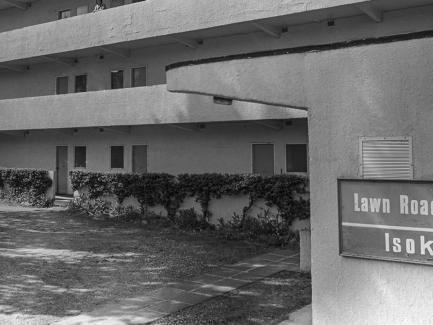Isokon Symposium
Friday, April 21, 2023
A pioneer in its approach to materials, marketing, and design, Isokon Ltd was instrumental in introducing functional modernism to England between the wars. Established in 1932 by the progressive entrepreneur Jack Pritchard (1899–1992), the firm became known for the sleek, ocean-liner-inspired apartment building on Lawn Road in London, designed by Wells Coates (1895–1958) in 1934, and the iconic collection of bent-plywood furniture, much of it designed by Marcel Breuer (1902–1981). Together these endeavors gave form to a radical new way of living and have inspired generations of designers since.
The story of Isokon is the story of multiculturalism and creative exchange among a vibrant, if intimate, modernist milieu in 1930s London. The striking Lawn Road building, nestled in the historic area of Hampstead, was at the epicenter of the avant-garde community and attracted progressive artists, architects, and writers sympathetic to the model of efficient, collective living it exemplified. Among its residents were Bauhaus masters Breuer, Walter Gropius (1883–1969), and László Moholy-Nagy (1895–1946), who fled Nazi Germany with Pritchard's assistance and subsequently became the backbone of the Isokon design team.
The small but significant range of furniture produced by Isokon in the 1930s marked a new direction for modernist design that combined the sleek machine aesthetic of the Bauhaus with an organicism particular to British modernism. Made using affordable materials and novel modes of production, this collection embedded Isokon in avant-garde discourse about revolutionary design and its impact on social life.
The Yale Center for British Art (YCBA) is hosting a one-day, online symposium exploring all aspects of Isokon’s creative output. Seeking to move away from the overly simplistic narrative that it represented “the Bauhaus in London,” the symposium brings fresh insight about the hybridity of Isokon’s iconic aesthetic and its emergence from London’s cultural and modernist melting pot. We welcome proposals on any topic related to the architecture, furniture, and marketing designs produced by Isokon, the architects and designers it employed, and the occupants of the Lawn Road flats. Themes for consideration include:
- Networks of creative exchange between the Isokon architects/designers and avant-garde artists, architects, and critics in 1930s London
- The role of Isokon designs in discourse about revolutionary aesthetics
- Critical reception of Isokon furniture and the Lawn Road flats
- The design, materials, and manufacture of Isokon furniture
- Coates and the architecture of the Lawn Road flats
- Isokon branding, advertising, and other visual media
- Avant-garde photography and the documentation of Isokon architecture and furniture, including but not limited to that by Edith Tudor-Hart (1908–1973) and John Havinden (1908–1987)
- Other furniture designed by Breuer, Gropius, Ernest Race (1913–1964), and Egon Riss (1901–1964) while living in England
- The influence of Isokon on other furniture designers and architects at the time and up to the present
The deadline to submit an abstract for the Isokon Symposium has passed.
